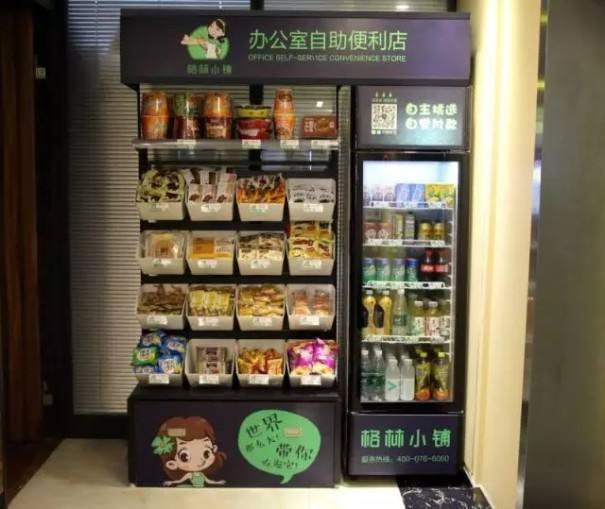The online traffic dividend has bottomed out, and Internet giants and entrepreneurs have turned their attention to offline, hoping to make new breakthroughs based on offline traffic and feed back online. Alibaba has laid out new retail Tmall stores, and JD.com Xintong Road has launched a million-dollar convenience store plan, with unmanned convenience stores, unmanned gyms, and unmanned KTVs all appearing for a while.
As a new entrepreneurial project, due to its small but light, low cost and low barriers, office unmanned shelves have been sought after by many investment institutions this year. According to media statistics, since the rapid rise of unmanned shelf projects in August, in just two months, there have been more than 35 unmanned shelf projects such as snack e-home, Xiaoeweidian, Xingyi, Qizhai Koala, Guo Xiaomei, Youbo, and nearly 30 have been disclosed to have received financing, of which the amount of a single financing exceeds 100 million yuan, and the cumulative investment amount exceeds 3 billion yuan. Alibaba (all involved in Ele.me and Hema Fresh), JD.com, and Meituan giants have entered the market to share the food. The Ministry of Commerce has spoken out to support the development of related business formats. The game of unmanned shelf seems to be expected to reappear the grand occasion of the O2O war. Whether it is a mess in the end depends on how entrepreneurs play.

Why are unmanned shelves sought after by capital?
1. Market demand of hundreds of billions
As China's economy continues to rise, the new urban middle class gradually develops, and a considerable number of urban white-collar workers with purchasing power have formed a considerable consumer market. According to statistics, the annual compound growth rate of the retail market size of my country's snack food industry in the past two years has been above 10%. The retail market size of the snack food in 2016 was about 822.4 billion yuan, and some experts predict that the scale will reach 129.84 billion yuan by 2020.
Online shopping is delivered as soon as the same day, and convenience stores can only consume during the tight time before and after work. In contrast, when placed in the office, urban white-collar workers can buy their favorite snacks in just a few steps, which obviously meets the fast-paced urban consumption needs.
Buy a milk bread in the morning, eat some Weilong spicy strips with rice for lunch, a cup of Red Bull in the afternoon tea to refresh yourself, and make a bowl of old jars of pickled vegetables while working overtime to suffice your stomach. Such a consumption scenario is an important factor that attracts many investors to enter.
Up to now, the number of outlets disclosed by unmanned shelves has been about 10,000 yuan, and according to public information, there are about 2 million companies in Beijing, Shanghai, Guangzhou and Shenzhen alone. With the promotion of Internet technology and the entry of e-commerce giants, the concept of unmanned retail stores has gradually penetrated into users, and the user scale and transaction scale will show a blowout development in the next few years.
2. 8 hours of consumer time exclusive
Unlike other retail models, unmanned shelves are placed in the office and appear in front of consumers every moment within 8 hours of work. Now that consumer time competition is in full swing, 8 hours of consumer time exclusiveness is a unique advantage of unmanned shelves in the office.
There is no need to wait for online shopping, no need to consume the convenience store, and unmanned shelves are infinitely close to consumers in terms of physical distance, which eliminates consumers' time and space concerns and is more likely to cause impulsive consumption.
3. New traffic entrance with imaginative space
The office is a high-frequency offline traffic entrance. Unmanned shelves can obtain and accumulate these traffic without paying extra costs, becoming a new retail entrance. With considerable office traffic, whether it is to monetize advertising as a marketing portal, draw consumer user group images as a data collection portal, or feed back online traffic, it can bring good returns to investors.
4. A relatively low entry threshold
Unlike convenience stores that have to bear rental pressure, unmanned shelves occupy a small area. As a company's welfare, there is even no rental requirement. An ordinary display shelves cost about 300 yuan, the total price of the goods is about 600 yuan, and the BD cost is about 100 yuan, which means that the initial cost of laying a point is about 1,000 yuan.
Not being used in unmanned vending machines requires relatively high installation costs and technical thresholds. Unmanned shelves do not require a lot of technological expenses, such as the purchase, installation and repair of machines, and only a low-cost shelves are required. On the other hand, the configuration threshold for unmanned shelves is low, the operating costs of employees are relatively low, and there are fewer requirements for the operation team.
Unmanned shelves mostly use Alipay or WeChat payment, which is almost no difficulty for office white-collar workers. Consumers can easily complete the entire transaction process, and the delivery experience is convenient and easy. At the same time, because it is placed in a place like the office, office employees can supervise each other, which to a certain extent avoids problems such as loss of goods and damage to the shelves.
5. Upgradable business model
Unmanned shelves in offices are not limited to selling snacks. As outlets are spread out, upgrading the shelf to meet the further needs of consumers has become a natural problem.
Introducing exclusive products to improve user stickiness; companies with refrigerated and frozen containers can differentiate through fresh fruits, cold drinks and other products; even consider introducing short-term cooked foods, such as pre-packaged lunch boxes, etc. after the market is mature, the supply chain is perfect, and daily operations are stable; can we use unmanned shelves to do group buying business through the office acquaintance relationship chain, that is, Pinduoduo within the office? After the user scale is large enough, can we change from a channel brand to a consumer brand, that is, we can reverse customization through ODM and try NetEase Yanxuan model? These are all business directions that can be tried.
Not all startups are suitable for unmanned shelves
1. Limited market and crazy entrants
Unmanned shelves have considerable requirements for consumer consumption capacity, consumption scenarios, industries and consumer quality. For large enterprises like JD.com with tens of thousands of employees, it is certainly okay to put hundreds of shelves in the headquarters building, but if unmanned shelves are placed at distribution points with highly dense personnel flow, you don’t have to think about it and the cargo loss rate will be quite astonishing. The lessons of the little yellow car lies there.
Data in 2015 showed that among the 180.625 million people employed in urban units, there were only four industries with more than 10 million employed, namely: 50.687 million in manufacturing, 27.96 million in construction, 17.365 million in education, and 16.378 million in public management and social organizations. Correspondingly, the number of employed people in the information transmission and computer software industries is 3.499 million! (Data source: National Bureau of Statistics)
In fact, most of the people who are suitable for placing unmanned shelves are Internet companies, such as the education industry, public institutions, manufacturing industry, and construction industry. There are not as many spaces for placing unmanned shelves as imagined. Among the companies that have entered the unmanned shelves, more than 30 have received financing alone. The relatively "small" market space will obviously become crowded, and in the end, 1-2 companies may be left to survive.
2. Moral problems: damage rate
According to media reports, after the unmanned shelf project "Use Dim Sum Bar" has laid 64 unmanned shelves, it was found that the cargo loss rate exceeded 10%, and the most serious cargo loss even reached 39%. It is difficult for the retail industry to make a net profit exceeding 10%. Once the cargo loss rate reaches 10%, the company is basically in a loss state.
Due to the special form of unmanned shelves, the damage rate will become a key problem for operators to solve. How to control the damage rate within a reasonable range through user education, user selection, mechanism design, etc. from the control of various aspects such as shelf location, product selection, unit price planning, and daily operation supervision, and control the damage rate within a reasonable range through user education, user selection, mechanism design, etc. is a problem that all entrants need to solve. Putting too high requirements on user quality will inevitably affect the expansion of user scale, and complex mechanism design will increase operational costs and affect user experience. This is a contest between operators and human nature.
3. Winners take all
Like other Internet projects, unmanned shelves also apply to the winner-take-all rule.
The office space is limited, and it is impossible for small shelves to place too many skus; the consumption needs of different office consumers are highly personalized and need to rely on efficient and accurate data analysis to meet consumer needs; consumers in the same office are seriously homogeneous, and consumption levels are difficult to vary, and it is relatively difficult to collect user information; unmanned shelves mainly benchmark against the immediate demand market, selling snack foods, the gross profit margin is relatively low, and the cost recovery cycle is relatively long; sales clerks are not required, but there are too many high-frequency, fast, and small-batch logistics and moving goods, and the back-end cost is not as low as imagined.
The above problems must be solved after the shelf density reaches a certain level, through scale, build intelligent big data, and use customers to drive business upgrades. Just like the scene of the Hundred Regiments War was reappearing, unmanned shelves were trying their best to do door-to-door ground push, hoping to take the lead in occupying the market.
4. Supply Chain Requirements
When an outlet owned by an unmanned shelves is below a certain order of magnitude, the competition threshold is indeed very low, but as the scale continues to expand, high requirements will be placed on operational and supply chain efficiency. Since each company's product digestibility and category preferences are different, complex supply chain management will be a major difficulty.
How to expand new shelves, how fast and how much cost is; how much monthly orders for a single shelf, how much sales, how much customer unit price, how much profit margin; how to do delivery, how many delivery frequency, how much delivery cost, how much loss rate, etc. These problems cannot be solved by any company. This requires the strong refined operational capabilities and supply chain strength of the team behind it.
Behind unmanned shelves, a strong supply chain and distribution team are needed, intensive deployment and refined operations are needed to maintain considerable profit margins. It seems that the entry threshold is very low, but it is still an asset-heavy business in essence.
7-Where does Eleven convenience store win? It is not convenient, but wins in the supply chain and the logistics distribution system. For example, in order to ensure product quality to the limit, especially the freshness of food, 7-Eleven conducts "temperature management" for logistics and distribution. According to the temperature requirements of different products, the products are divided into four temperature zones: freezing, refrigeration, warm and room temperature, for temperature isolation storage and distribution. At the same time, in order to better meet the high-frequency and small-batch logistics needs of convenience stores, 7-Eleven concentrates the supply needs of each store to deliver uniformly, reduce logistics costs and shorten delivery time.
To a certain extent, unmanned shelves are a supplement to the retail format, and the market share they cut out is the part of customers that convenience stores and online shopping cannot satisfy. If unmanned shelves want to survive the fierce market competition, they must restructure the supply chain, support on-demand ordering, support multiple varieties, small batches, and rapid response, achieving personalization, fast, low cost and richness, and ultimately widen the gap with competitors in terms of data product selection, rapid response and replenishment costs.
5. Social positioning
Just as a convenience store is no longer just a small store selling food, but by continuously enriching services, selling fresh processed products, hot food, daily necessities and even some life services, the unmanned shelves that simply sell snacks cannot adapt to the new consumption trend under new retail.
For new consumers, not paying too much attention to price and preferring emotional satisfaction is an important feature. The issue that office unmanned shelves needs to be paid attention to is not only to let consumers buy the goods they want, but more importantly, to integrate into their office culture and become a social scene for them. Only in this way can consumers be enhanced, multiple purchases can be promoted, and competitive barriers can be built.
Driven by technology, the retail industry has never changed its core from the era of the original cargo yard to the consignee, and then to the cargo yard. To put it bluntly, from the era of content as king, channel as king to consumers as king, its core has never changed, and it has always been cost, efficiency and experience. Unmanned shelves target the rapid urban consumption needs of office white-collar workers and have proposed their own solutions, but whether they can control costs, improve efficiency, and upgrade their experience depends on the practice of each entrepreneur.
Thank you for your attention and support to Laogao E-commerce Club . Please indicate the source of the reprinting website www.shxuanming.net
Click to register to apply to join the well-known e-commerce network - Laogao E-commerce Club. Any merchants from all over the country, Tmall merchants, Taobao Crown Store, Jinguan Store, and other e-commerce platform merchants can apply to join!






 EN
EN CN
CN
